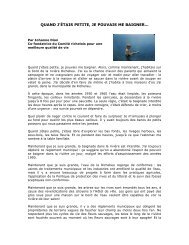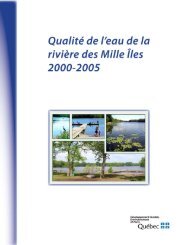Simulation of Aerodynamic Divergence and Flutter on Wind ...
Simulation of Aerodynamic Divergence and Flutter on Wind ...
Simulation of Aerodynamic Divergence and Flutter on Wind ...
Create successful ePaper yourself
Turn your PDF publications into a flip-book with our unique Google optimized e-Paper software.
<str<strong>on</strong>g>Simulati<strong>on</strong></str<strong>on</strong>g> <str<strong>on</strong>g>of</str<strong>on</strong>g> <str<strong>on</strong>g>Aerodynamic</str<strong>on</strong>g> <str<strong>on</strong>g>Divergence</str<strong>on</strong>g> <str<strong>on</strong>g>and</str<strong>on</strong>g> <str<strong>on</strong>g>Flutter</str<strong>on</strong>g> <strong>on</strong><br />
<strong>Wind</strong> Turbines using ANSYS-CFX<br />
Drishtysingh Ramdenee 1 , Sorin I<strong>on</strong> Minea 1 <str<strong>on</strong>g>and</str<strong>on</strong>g> Adrian Ilinca 1<br />
1 <strong>Wind</strong> Energy Research Laboratory, Université Du Québec à Rimouski<br />
ABSTRACT<br />
Email: Author@eng.uwo.ca<br />
The recent development <str<strong>on</strong>g>of</str<strong>on</strong>g> large wind turbines poses<br />
new challenges with regard to underst<str<strong>on</strong>g>and</str<strong>on</strong>g>ing the<br />
mechanisms surrounding unsteady flow-structure<br />
interacti<strong>on</strong>. The larger <str<strong>on</strong>g>and</str<strong>on</strong>g> more flexible blades<br />
imply risks from an aeroelastic point <str<strong>on</strong>g>of</str<strong>on</strong>g> view <str<strong>on</strong>g>and</str<strong>on</strong>g><br />
urge the need to properly underst<str<strong>on</strong>g>and</str<strong>on</strong>g> <str<strong>on</strong>g>and</str<strong>on</strong>g> model these<br />
phenomena. Due to limited experimental data<br />
available in this field, Computati<strong>on</strong>al Fluid dynamics<br />
(CFD) techniques provide an invaluable alternative to<br />
identify <str<strong>on</strong>g>and</str<strong>on</strong>g> model aerodynamic <str<strong>on</strong>g>and</str<strong>on</strong>g> aeroelastic<br />
phenomena around the wind blades. The study is part<br />
<str<strong>on</strong>g>of</str<strong>on</strong>g> the coupling between aerodynamic <str<strong>on</strong>g>and</str<strong>on</strong>g> elastic<br />
models <str<strong>on</strong>g>of</str<strong>on</strong>g> the commercial code - CFX with ANSYS,<br />
respectively. In this paper we are modeling the<br />
aeroelastic divergence. This article presents the the<br />
studies aiming at modeling divergence. In this article<br />
the results <str<strong>on</strong>g>of</str<strong>on</strong>g> the divergence modeling using ANSYS-<br />
CFX will be presented <str<strong>on</strong>g>and</str<strong>on</strong>g> compared with results<br />
from “Jennifer Heeg” [13]. The study is realized <strong>on</strong><br />
the NACA0012 airfoil for which experimental data<br />
are available in literature. The ANSYS workbench is<br />
used for the fluid structure interacti<strong>on</strong> to simulate the<br />
divergence phenomen<strong>on</strong> which is a structural<br />
resp<strong>on</strong>se imposed by aerodynamic loads due to<br />
transient fluid flow.<br />
1. INTRODUTION<br />
An aeroelastic instability occurs when the variati<strong>on</strong> in<br />
the aerodynamic forces resulting from the blade<br />
displacement tends to amplify the latter. The most<br />
comm<strong>on</strong>ly occurring aeroelastic phenomena with<br />
wind turbines are stall induced vibrati<strong>on</strong>s. <str<strong>on</strong>g>Flutter</str<strong>on</strong>g> is<br />
another instability problem that needs to be inspected<br />
<str<strong>on</strong>g>and</str<strong>on</strong>g> understood in an aim to mitigate it. Stall induced<br />
vibrati<strong>on</strong>s occur in dynamic stall c<strong>on</strong>trolled wind<br />
turbines. The gradient <str<strong>on</strong>g>of</str<strong>on</strong>g> the power coefficient curve<br />
becomes negative when part <str<strong>on</strong>g>of</str<strong>on</strong>g> the blade is<br />
subjected to stall, having as result a local negative<br />
aerodynamic damping <str<strong>on</strong>g>of</str<strong>on</strong>g> the blade movement in the<br />
directi<strong>on</strong> <str<strong>on</strong>g>of</str<strong>on</strong>g> the lift. If the global aerodynamic<br />
damping for a particular vibrati<strong>on</strong> mode is negative,<br />
<str<strong>on</strong>g>and</str<strong>on</strong>g> exceeds (in magnitude) the structural modal<br />
damping, then the oscillati<strong>on</strong>s can be amplified from<br />
any initial perturbati<strong>on</strong> independent <str<strong>on</strong>g>of</str<strong>on</strong>g> the ratio<br />
between the normal frequency <str<strong>on</strong>g>of</str<strong>on</strong>g> the vibrati<strong>on</strong> mode<br />
<str<strong>on</strong>g>and</str<strong>on</strong>g> the excitati<strong>on</strong> frequencies. The first mode in each<br />
directi<strong>on</strong> is more pr<strong>on</strong>e to such a behavior as the<br />
structural damping increases with the frequency<br />
whereas the aerodynamic damping decreases. On the<br />
other h<str<strong>on</strong>g>and</str<strong>on</strong>g>, flutter is a very dangerous phenomen<strong>on</strong><br />
which results from an interacti<strong>on</strong> between elastic,<br />
inertial <str<strong>on</strong>g>and</str<strong>on</strong>g> aerodynamic forces. It occurs when<br />
structural damping becomes insufficient to damp<br />
aerodynamically induced vibrati<strong>on</strong> moti<strong>on</strong>s. <str<strong>on</strong>g>Flutter</str<strong>on</strong>g> is<br />
caused by the superpositi<strong>on</strong> <str<strong>on</strong>g>of</str<strong>on</strong>g> two structural modes –<br />
pitch <str<strong>on</strong>g>and</str<strong>on</strong>g> plunge. The pitch mode is described by a<br />
rotati<strong>on</strong>al movement about the elastic centre <str<strong>on</strong>g>of</str<strong>on</strong>g> the<br />
airfoil whereas the plunge mode is a vertical up <str<strong>on</strong>g>and</str<strong>on</strong>g><br />
down moti<strong>on</strong> at the blade tip. As wind speed<br />
increases, the frequencies <str<strong>on</strong>g>of</str<strong>on</strong>g> these modes coalesce to<br />
create the flutter moti<strong>on</strong>. This is called flutter<br />
res<strong>on</strong>ance. Usually, flutter is initiated as the airfoil is<br />
subjected to an initial rotati<strong>on</strong>. As a divergence like<br />
phenomena arises, the torsi<strong>on</strong>al stiffness <str<strong>on</strong>g>of</str<strong>on</strong>g> the blade<br />
reacts to achieve zero rotati<strong>on</strong> again. On the other<br />
h<str<strong>on</strong>g>and</str<strong>on</strong>g>, the resistance to bending tries to restore a<br />
neutral positi<strong>on</strong> <str<strong>on</strong>g>and</str<strong>on</strong>g> sets the airfoil in a nose down<br />
rotati<strong>on</strong> positi<strong>on</strong>. The amplified force causes<br />
plunging <str<strong>on</strong>g>and</str<strong>on</strong>g> torsi<strong>on</strong>al stiffness to restore zero<br />
rotati<strong>on</strong>. With time, though [1] the plunging moti<strong>on</strong><br />
tends to damp out, the rotati<strong>on</strong> moti<strong>on</strong> diverges till<br />
failure.<br />
2. CHALLENGE IN MODELING<br />
AEROELASTIC PHENOMENA<br />
Modeling <str<strong>on</strong>g>of</str<strong>on</strong>g> aeroelastic phenomena requires coupling<br />
<str<strong>on</strong>g>of</str<strong>on</strong>g> aerodynamic <str<strong>on</strong>g>and</str<strong>on</strong>g> structural equati<strong>on</strong>s <str<strong>on</strong>g>and</str<strong>on</strong>g> such<br />
represents a particular challenge. The need to obtain<br />
soluti<strong>on</strong>s for several combinati<strong>on</strong>s <str<strong>on</strong>g>of</str<strong>on</strong>g> the parameters<br />
<str<strong>on</strong>g>of</str<strong>on</strong>g> the structure <str<strong>on</strong>g>and</str<strong>on</strong>g> the fluid require very precise<br />
modeling <str<strong>on</strong>g>of</str<strong>on</strong>g> the fluid model soluti<strong>on</strong>s <str<strong>on</strong>g>and</str<strong>on</strong>g> this is very<br />
dem<str<strong>on</strong>g>and</str<strong>on</strong>g>ing from a computati<strong>on</strong>al point <str<strong>on</strong>g>of</str<strong>on</strong>g> view. For<br />
several years the finite element model size has been<br />
reduced. This has been possible by first finding the<br />
Eigen modes <str<strong>on</strong>g>and</str<strong>on</strong>g> using a discrete set <str<strong>on</strong>g>of</str<strong>on</strong>g> values to
ebuild a discrete structure up<strong>on</strong> which the modeling<br />
is performed. Lagrangian equati<strong>on</strong>s <str<strong>on</strong>g>of</str<strong>on</strong>g> classical<br />
dynamics are made use <str<strong>on</strong>g>of</str<strong>on</strong>g> <str<strong>on</strong>g>and</str<strong>on</strong>g> the computati<strong>on</strong>al<br />
requirements are appreciably reduced. Usually a<br />
finite element structural model with some thous<str<strong>on</strong>g>and</str<strong>on</strong>g>s<br />
<str<strong>on</strong>g>of</str<strong>on</strong>g> degree <str<strong>on</strong>g>of</str<strong>on</strong>g> freedom (DoF) can be reduced into <strong>on</strong>e<br />
<str<strong>on</strong>g>of</str<strong>on</strong>g> some ten DoF.[2]. Though, this method is highly<br />
c<strong>on</strong>venient in terms <str<strong>on</strong>g>of</str<strong>on</strong>g> computati<strong>on</strong>al needs, it is very<br />
tedious <str<strong>on</strong>g>and</str<strong>on</strong>g> requires refined modeling at each step.<br />
3. ANSYS-CFX COUPLING<br />
In order to realize the fluid structure coupling study,<br />
we make use <str<strong>on</strong>g>of</str<strong>on</strong>g> ANSYS multi domain (MFX). This<br />
module was primarily developed for fluid-structure<br />
interacti<strong>on</strong> studies. On <strong>on</strong>e side, the structural part is<br />
solved using ANSYS Multiphysics <str<strong>on</strong>g>and</str<strong>on</strong>g> <strong>on</strong> the other<br />
side, the fluid part is solved using ANSYS CFX. The<br />
study needs to be c<strong>on</strong>ducted <strong>on</strong> a 3D geometry.<br />
However, if the geometries used by ANSYS <str<strong>on</strong>g>and</str<strong>on</strong>g> CFX<br />
need to have comm<strong>on</strong> surfaces (interfaces), the<br />
meshes <str<strong>on</strong>g>of</str<strong>on</strong>g> these surfaces need not be identical [3].<br />
The ANSYS code acts as the master code <str<strong>on</strong>g>and</str<strong>on</strong>g> reads<br />
all the multi-domain comm<str<strong>on</strong>g>and</str<strong>on</strong>g>s. It recuperates the<br />
interface meshes <str<strong>on</strong>g>of</str<strong>on</strong>g> the CFX code, creates the<br />
mapping <str<strong>on</strong>g>and</str<strong>on</strong>g> communicates the parameters that<br />
c<strong>on</strong>trol the timescale <str<strong>on</strong>g>and</str<strong>on</strong>g> coupling loops to the CFX<br />
code. The ANSYS generated mapping interpolates<br />
the solicitati<strong>on</strong>s between the different meshes <strong>on</strong> each<br />
side <str<strong>on</strong>g>of</str<strong>on</strong>g> the coupling. Each solver realizes a sequence<br />
<str<strong>on</strong>g>of</str<strong>on</strong>g> multi-domain time steps <str<strong>on</strong>g>and</str<strong>on</strong>g> coupling iterati<strong>on</strong>s<br />
between each time steps. For each iterati<strong>on</strong>, each<br />
solver recuperates its required solicitati<strong>on</strong> from the<br />
other domain <str<strong>on</strong>g>and</str<strong>on</strong>g> then solves it physical domain.<br />
Each element <str<strong>on</strong>g>of</str<strong>on</strong>g> interface is initially divided into n<br />
interpolati<strong>on</strong> faces (IP) where n is the number <str<strong>on</strong>g>of</str<strong>on</strong>g><br />
nodes <strong>on</strong> that face. The 3D IP faces are transformed<br />
into 2D polyg<strong>on</strong>s. We, then, create the intersecti<strong>on</strong><br />
between these polyg<strong>on</strong>s, <strong>on</strong> <strong>on</strong>e h<str<strong>on</strong>g>and</str<strong>on</strong>g>, the solver<br />
diffusing solicitati<strong>on</strong>s <str<strong>on</strong>g>and</str<strong>on</strong>g> <strong>on</strong> the other h<str<strong>on</strong>g>and</str<strong>on</strong>g>, the<br />
solver receiving the solicitati<strong>on</strong>s. This intersecti<strong>on</strong><br />
creates a large number <str<strong>on</strong>g>of</str<strong>on</strong>g> surfaces called c<strong>on</strong>trol<br />
surfaces as illustrated in figure 1.<br />
Figure 1: Transfer Surfaces <str<strong>on</strong>g>and</str<strong>on</strong>g> resoluti<strong>on</strong> scheme<br />
These surfaces are made use <str<strong>on</strong>g>of</str<strong>on</strong>g> in order to transfer<br />
the solicitati<strong>on</strong> between the structural <str<strong>on</strong>g>and</str<strong>on</strong>g> fluid<br />
domains. In the case <str<strong>on</strong>g>of</str<strong>on</strong>g> the divergence, it is the fluid<br />
that imposes the solicitati<strong>on</strong>s <strong>on</strong> the solid such that<br />
the CFX code will be the first to be solved followed<br />
by the ANSYS code.<br />
.<br />
4. STATE OF THE ART<br />
There has been little, if not, no article that p<strong>on</strong>dered<br />
<strong>on</strong> the modeling <str<strong>on</strong>g>of</str<strong>on</strong>g> divergence modeling as from subcritical<br />
c<strong>on</strong>diti<strong>on</strong>s till failure. This can be explained<br />
by the difficulties encountered by s<str<strong>on</strong>g>of</str<strong>on</strong>g>tware to model<br />
acute gradients in the proximity <str<strong>on</strong>g>of</str<strong>on</strong>g> divergence <str<strong>on</strong>g>and</str<strong>on</strong>g>,<br />
also, due to the fact that the primary importance is<br />
<strong>on</strong>ly to analyze stability <str<strong>on</strong>g>and</str<strong>on</strong>g> sub-critical speed <str<strong>on</strong>g>and</str<strong>on</strong>g> to<br />
design the system in order for the latter to stay within<br />
these c<strong>on</strong>diti<strong>on</strong>s at all time. [3] has illustrated the<br />
dramatic reducti<strong>on</strong> in the divergence speed for a<br />
reversed arrow wing. [4] went further with the works<br />
presented in [3] <str<strong>on</strong>g>and</str<strong>on</strong>g> proposes an analytical method to<br />
calculate the divergence speed <str<strong>on</strong>g>of</str<strong>on</strong>g> the airfoils. [5]<br />
clearly illustrated the destructive nature <str<strong>on</strong>g>of</str<strong>on</strong>g> divergence<br />
<str<strong>on</strong>g>and</str<strong>on</strong>g> the possibility <str<strong>on</strong>g>of</str<strong>on</strong>g> c<strong>on</strong>trolling the latter. [6]<br />
realized wind tunnel experiments which showed the<br />
fundamental relati<strong>on</strong>ship between the angle <str<strong>on</strong>g>of</str<strong>on</strong>g> the<br />
blade, the orientati<strong>on</strong> <str<strong>on</strong>g>of</str<strong>on</strong>g> the material fibers <str<strong>on</strong>g>and</str<strong>on</strong>g> the<br />
divergence speed. “Rodney H.Ricketts, <str<strong>on</strong>g>and</str<strong>on</strong>g> Robert<br />
V.Doggett, Jr” [7] makes use <str<strong>on</strong>g>of</str<strong>on</strong>g> flat plate models<br />
with varying geometries <str<strong>on</strong>g>and</str<strong>on</strong>g> their subcritical<br />
resp<strong>on</strong>se testing techniques were formulated <str<strong>on</strong>g>and</str<strong>on</strong>g><br />
evaluated for accuracy in predicting static<br />
divergence. “Sefic, Walter J., <str<strong>on</strong>g>and</str<strong>on</strong>g> Cleo M.Maxwell”<br />
[8] did experiments to correlate flight data with<br />
predicted structural stability <str<strong>on</strong>g>and</str<strong>on</strong>g> determinati<strong>on</strong> <str<strong>on</strong>g>of</str<strong>on</strong>g><br />
aeroservoelastic stability margins. “Stanley R. Cole,<br />
James R. Florance, Lee B. Thmps<strong>on</strong>, Charles<br />
V.Spain <str<strong>on</strong>g>and</str<strong>on</strong>g> Ellen P.Bullock” [9] made use <str<strong>on</strong>g>of</str<strong>on</strong>g><br />
experimental data obtained from supers<strong>on</strong>ic tests at<br />
the Unitary Plan <strong>Wind</strong> Tunnel at the NASA Langley<br />
Research Center to examine the divergence <str<strong>on</strong>g>of</str<strong>on</strong>g> all<br />
moveable parts. [10] has performed experiments to<br />
correlate flight results with predicted structural<br />
stability <str<strong>on</strong>g>and</str<strong>on</strong>g> the determinati<strong>on</strong> <str<strong>on</strong>g>of</str<strong>on</strong>g> aerservoelastic<br />
stability. A more detailed literature review is<br />
available in previous works [11] <str<strong>on</strong>g>and</str<strong>on</strong>g> [12]. The<br />
literature surrounding the divergence phenomen<strong>on</strong> is<br />
very large <str<strong>on</strong>g>and</str<strong>on</strong>g> includes several models all mostly<br />
aiming at modeling sub-critical velocity, dynamic<br />
pressure <str<strong>on</strong>g>and</str<strong>on</strong>g> the modal frequency within the stability<br />
z<strong>on</strong>e. Most works dealing with experimental analysis<br />
have lengthily discussed <strong>on</strong> the errors <str<strong>on</strong>g>and</str<strong>on</strong>g> the<br />
graphical results provide a domain <str<strong>on</strong>g>of</str<strong>on</strong>g> divergence<br />
rather than a fixed value. The c<strong>on</strong>sulted literature has<br />
been very broad, though, not exhaustive, <str<strong>on</strong>g>and</str<strong>on</strong>g> the
fundamental philosophy has been the same: the<br />
objective <str<strong>on</strong>g>of</str<strong>on</strong>g> most aeroelastic work have most <str<strong>on</strong>g>of</str<strong>on</strong>g> the<br />
time underlined the c<strong>on</strong>sequences <str<strong>on</strong>g>of</str<strong>on</strong>g> divergence <str<strong>on</strong>g>and</str<strong>on</strong>g><br />
flutter, the sub-critical behavior <str<strong>on</strong>g>of</str<strong>on</strong>g> structures in order<br />
to be able to know how far we are from the critical<br />
z<strong>on</strong>es in order to avoid them. Modeling <str<strong>on</strong>g>of</str<strong>on</strong>g> these<br />
phenomena has <strong>on</strong>ly been a very limited part <str<strong>on</strong>g>of</str<strong>on</strong>g> the<br />
works.<br />
5. EXPERIMENTAL VALIDATION<br />
In 2000, Jennifer Heeg [13] realised aeroelastic<br />
experiments at the Duke University wind Tunnel.<br />
The aim was to validate analytical calculati<strong>on</strong>s <str<strong>on</strong>g>of</str<strong>on</strong>g> n<strong>on</strong><br />
critical characteristic modes <str<strong>on</strong>g>and</str<strong>on</strong>g> explicitly examine<br />
the aerodynamic divergence phenomen<strong>on</strong>. The<br />
simplest model was built <str<strong>on</strong>g>and</str<strong>on</strong>g> tested. A NACA 0012<br />
airfoil was used <str<strong>on</strong>g>and</str<strong>on</strong>g> the structure was <strong>on</strong>ly allowed a<br />
single DoF, i.e., in torsi<strong>on</strong>. A chord length <str<strong>on</strong>g>of</str<strong>on</strong>g> 8 inches<br />
<str<strong>on</strong>g>and</str<strong>on</strong>g> a blade length <str<strong>on</strong>g>of</str<strong>on</strong>g> 21 inches were made use <str<strong>on</strong>g>of</str<strong>on</strong>g>.<br />
The wing was made out <str<strong>on</strong>g>of</str<strong>on</strong>g> an aluminum shell <str<strong>on</strong>g>of</str<strong>on</strong>g> 1/32<br />
inches in thickness. A spring c<strong>on</strong>stant <str<strong>on</strong>g>of</str<strong>on</strong>g> 5.826<br />
N·m/rad was used. The structural dynamic<br />
parameters for this model are summarized in table 1:<br />
Elastic<br />
C<strong>on</strong>stant Kα<br />
[N∙m/rad]<br />
Natural<br />
pulsati<strong>on</strong> ωα<br />
[rad/sec]<br />
Natural<br />
Frequency fα<br />
[Hz]<br />
Damping ratio<br />
5.8262 49.5 7.88 0.053<br />
Table 1: Structural dynamic parameters associated to<br />
the model used for the wind tunnel experiment from<br />
[13]<br />
The objectives <str<strong>on</strong>g>of</str<strong>on</strong>g> the studies in [13] were to : 1)<br />
calculate the dynamic pressure at divergence, 2)<br />
examine the modal characteristics <str<strong>on</strong>g>of</str<strong>on</strong>g> n<strong>on</strong> critical<br />
modes, 3) examine the behavior <str<strong>on</strong>g>of</str<strong>on</strong>g> Eigen vectors.The<br />
aim <str<strong>on</strong>g>of</str<strong>on</strong>g> our simulati<strong>on</strong>s is to be able to simulate the<br />
same using ANSYS- CFX coupling.<br />
6. SIMULATION MODEL<br />
The model <str<strong>on</strong>g>of</str<strong>on</strong>g> the experiment was simulated at a<br />
reduced scale, in order to reduce the calculati<strong>on</strong> time<br />
by reducing the dimensi<strong>on</strong>s <str<strong>on</strong>g>of</str<strong>on</strong>g> the fluid domain. The<br />
span <str<strong>on</strong>g>of</str<strong>on</strong>g> the airfoil was reduced 262.5 times, from 21<br />
inches to 0.08 inches or 2.032 mm, while the chord <str<strong>on</strong>g>of</str<strong>on</strong>g><br />
the airfoil was maintained at 8 inch or 203.2 mm. We<br />
used a cylinder to simulate the torsi<strong>on</strong> spring used in<br />
the c<strong>on</strong>figurati<strong>on</strong> <str<strong>on</strong>g>of</str<strong>on</strong>g> the experiment that was detailed<br />
in the previous secti<strong>on</strong>. The c<strong>on</strong>stant <str<strong>on</strong>g>of</str<strong>on</strong>g> the original<br />
spring is K = 5.8262 N∙m/rad <str<strong>on</strong>g>and</str<strong>on</strong>g> since we used a<br />
reduced model, with an span 262.5 times smaller than<br />
the original, the dimensi<strong>on</strong>s <str<strong>on</strong>g>and</str<strong>on</strong>g> properties <str<strong>on</strong>g>of</str<strong>on</strong>g> the<br />
cylinder are such that:<br />
= 0.022195 N∙ m/ rad<br />
ζ<br />
The mass <str<strong>on</strong>g>of</str<strong>on</strong>g> the c<strong>on</strong>sidered c<strong>on</strong>figurati<strong>on</strong> <str<strong>on</strong>g>of</str<strong>on</strong>g> the<br />
original model is 2.2864 kg, <str<strong>on</strong>g>and</str<strong>on</strong>g> the mass <str<strong>on</strong>g>of</str<strong>on</strong>g> our<br />
model is 262.5 times smaller, that is 0.00871 kg. The<br />
moment <str<strong>on</strong>g>of</str<strong>on</strong>g> inertia is such that our model has the<br />
same fundamental frequency as the original that is<br />
7.88 Hz. Figure 2 illustrates the model built <strong>on</strong><br />
ANSYS.<br />
Figure 2: Meshed ANSYS simulated model<br />
Details about the used fluid model are available from<br />
[14].<br />
7. RESULTS<br />
In a preliminary stage, prior to divergence <str<strong>on</strong>g>and</str<strong>on</strong>g> zer<str<strong>on</strong>g>of</str<strong>on</strong>g>requency<br />
flutter modeling, the lift coefficient curve<br />
for the model at a velocity <str<strong>on</strong>g>of</str<strong>on</strong>g> 20 m/s was c<strong>on</strong>structed<br />
using ANSYS <str<strong>on</strong>g>and</str<strong>on</strong>g> was compared to results from<br />
[13]. Furthermore, the ANSYS-CFX coupling was<br />
verified.<br />
7.1 C<strong>on</strong>structi<strong>on</strong> <str<strong>on</strong>g>of</str<strong>on</strong>g> the curve<br />
The curve was c<strong>on</strong>structed for a velocity <str<strong>on</strong>g>of</str<strong>on</strong>g> 20 m/s,<br />
which is between a velocity <str<strong>on</strong>g>of</str<strong>on</strong>g> 19.15 m/s estimated<br />
by [13] <str<strong>on</strong>g>and</str<strong>on</strong>g> 20.16 m/s which [13] used as comparis<strong>on</strong><br />
from experimental studies. For the validati<strong>on</strong> <str<strong>on</strong>g>of</str<strong>on</strong>g> our<br />
simulati<strong>on</strong>, we have used experimental data from<br />
[15] for Re numbers <str<strong>on</strong>g>of</str<strong>on</strong>g> Re = 1.7x10 5 <str<strong>on</strong>g>and</str<strong>on</strong>g> 3.3x10 5<br />
from which we interpolated values for Re =2.6x10 5<br />
corresp<strong>on</strong>ding to values used in our ANSYS-CFX<br />
simulati<strong>on</strong>. The result is shown in figure 3:<br />
CL<br />
1,2<br />
1<br />
0,8<br />
0,6<br />
0,4<br />
0,2<br />
Lift coefficient - CL(α)<br />
0<br />
0 2 4 6 8 10 12 14<br />
Figure 3: Lift coefficient curve <str<strong>on</strong>g>of</str<strong>on</strong>g> the NACA 0012 for Re =<br />
2.6x10 5 calculated using ANSYS-CFX <str<strong>on</strong>g>and</str<strong>on</strong>g> experimental<br />
results from Sheldahl & Klimas (blue circle for increasing<br />
angle <str<strong>on</strong>g>and</str<strong>on</strong>g> yellow triangle for decreasing angle)<br />
α
The results from ANSYS-CFX are in close<br />
accordance with experimental data till an AoA <str<strong>on</strong>g>of</str<strong>on</strong>g><br />
12°. At 2.5°, the results from CFX are inferior by<br />
13%, at à 4.5° by 20% <str<strong>on</strong>g>and</str<strong>on</strong>g> at 6.5° by 6%. The<br />
maximum value <str<strong>on</strong>g>of</str<strong>on</strong>g> the lift coefficient is achieved<br />
around 12° <str<strong>on</strong>g>and</str<strong>on</strong>g> is 0.96 <str<strong>on</strong>g>and</str<strong>on</strong>g> 0.9 at 10.5°. As for CFX<br />
achieved results, the maximum value is again<br />
achieved at around 12° <str<strong>on</strong>g>and</str<strong>on</strong>g> is 0.924 <str<strong>on</strong>g>and</str<strong>on</strong>g> 0.899 at<br />
10.5°. The difference in the values can be explained<br />
by the fact that Sheldahl & Klimas have extrapolated<br />
the obtained results from experiments using the<br />
s<str<strong>on</strong>g>of</str<strong>on</strong>g>tware PROFILE to estimate the aerodynamic<br />
coefficients from other Re numbers. Linearizati<strong>on</strong> <str<strong>on</strong>g>of</str<strong>on</strong>g><br />
the polars for low AoA had, also, been performed.<br />
7.2 Verificati<strong>on</strong> <str<strong>on</strong>g>of</str<strong>on</strong>g> the Coupling<br />
In order to verify the coupling between Mechanical<br />
APDL <str<strong>on</strong>g>and</str<strong>on</strong>g> CFX, we performed a simulati<strong>on</strong> at a<br />
c<strong>on</strong>stant flow below divergence. The pr<str<strong>on</strong>g>of</str<strong>on</strong>g>ile in [13]<br />
was fixed at α0 = 4°, restricted to <strong>on</strong>e DoF <str<strong>on</strong>g>and</str<strong>on</strong>g><br />
subjected to vair = 15 m/s as a shock wave. Figure 4<br />
illustrates the ANSYS-CFX generated resp<strong>on</strong>se. The<br />
represented variable is the vertical displacement <str<strong>on</strong>g>of</str<strong>on</strong>g><br />
the trailing edge. The equilibrium positi<strong>on</strong> induced<br />
force obtained from CFX is FL = 0.0363787 N. The<br />
AoA corresp<strong>on</strong>ding to a displacement <str<strong>on</strong>g>of</str<strong>on</strong>g> 0.006 m is,<br />
α = arcsine (sin (α0) + 0.006 / y0) = 7.022°, where y0<br />
= 0.1143 m. At this angle, the elastic moment is ME =<br />
K · (α – α0) = 0,022195 · 0.05275 = 0.00117 Nm.<br />
We obtain the same aerodynamic moment value from<br />
CFX.<br />
Figure 4: Oscillatory resp<strong>on</strong>se <str<strong>on</strong>g>of</str<strong>on</strong>g> the pr<str<strong>on</strong>g>of</str<strong>on</strong>g>ile subjected<br />
to a sudden shock wave <str<strong>on</strong>g>of</str<strong>on</strong>g> 15 m/s<br />
7.3 <str<strong>on</strong>g>Divergence</str<strong>on</strong>g> <str<strong>on</strong>g>and</str<strong>on</strong>g> flutter simulati<strong>on</strong><br />
The model from [13] was restricted from all DoF <str<strong>on</strong>g>and</str<strong>on</strong>g><br />
fixed to an AoA <str<strong>on</strong>g>of</str<strong>on</strong>g> 5°. For c<strong>on</strong>vergence needs, it was<br />
subjected to a c<strong>on</strong>stant velocity <str<strong>on</strong>g>of</str<strong>on</strong>g> 1 m/s till<br />
stabilisati<strong>on</strong> <str<strong>on</strong>g>of</str<strong>on</strong>g> the flow. The fixati<strong>on</strong> is then removed<br />
leaving a rotati<strong>on</strong> about the elastic axis <str<strong>on</strong>g>and</str<strong>on</strong>g> the<br />
velocity is increased according to the expressi<strong>on</strong> V =<br />
15.84 14.84*exp (-3*t) till 15.805 m/s at the end <str<strong>on</strong>g>of</str<strong>on</strong>g><br />
the simulati<strong>on</strong>. A time step <str<strong>on</strong>g>of</str<strong>on</strong>g> 3.8 10 -4 s is used<br />
though it would have been more interesting to use a<br />
variable time step to adjust with the Courant number.<br />
Figures 5 <str<strong>on</strong>g>and</str<strong>on</strong>g> 6 illustrate the resp<strong>on</strong>se <str<strong>on</strong>g>of</str<strong>on</strong>g> the blade<br />
provided by ANSYS-CFX. The represented variable<br />
is the AoA <str<strong>on</strong>g>of</str<strong>on</strong>g> the airfoil.<br />
Figure 5: nstability simulati<strong>on</strong> obtained for an AoA<br />
<str<strong>on</strong>g>of</str<strong>on</strong>g> 5 for c<strong>on</strong>figurati<strong>on</strong> #2 from [13]<br />
Figure 6: Instability simulati<strong>on</strong> obtained for an AoA<br />
<str<strong>on</strong>g>of</str<strong>on</strong>g> 5 0 for c<strong>on</strong>figurati<strong>on</strong> #2 from [13] with details<br />
The AoA <str<strong>on</strong>g>of</str<strong>on</strong>g> the airfoil increases progressively until it<br />
enters a regi<strong>on</strong> <str<strong>on</strong>g>of</str<strong>on</strong>g> stall c<strong>on</strong>trolled dynamic<br />
equilibrium. As the speed tends to 15.84 m/s, the<br />
AoA stays temporarily small, resting in equilibrium<br />
between the aerodynamic moment <str<strong>on</strong>g>and</str<strong>on</strong>g> the elastic<br />
moment between 10° <str<strong>on</strong>g>and</str<strong>on</strong>g> 10.5°. The <strong>on</strong>set <str<strong>on</strong>g>of</str<strong>on</strong>g> flutter<br />
is very quick due to the high gradient <str<strong>on</strong>g>of</str<strong>on</strong>g> the used<br />
velocity pr<str<strong>on</strong>g>of</str<strong>on</strong>g>ile which avoids any possibility <str<strong>on</strong>g>of</str<strong>on</strong>g> stall<br />
stabilizati<strong>on</strong>. The simulati<strong>on</strong> was stopped at 15 0<br />
because the Courant number ( ) reached 81.84<br />
which is much larger than the recommended value<br />
such that with the used time step, the analysis cannot<br />
go bey<strong>on</strong>d 15°.<br />
7.4 Discussi<strong>on</strong><br />
Due to numerical computati<strong>on</strong> limitati<strong>on</strong>s, we can<br />
<strong>on</strong>ly verify the frequency <str<strong>on</strong>g>of</str<strong>on</strong>g> the movement in a
velocity range between 15.6 <str<strong>on</strong>g>and</str<strong>on</strong>g> 15.8 m/s<br />
corresp<strong>on</strong>ding to a small error <str<strong>on</strong>g>of</str<strong>on</strong>g> 1.26 % which we<br />
judge very close to experimental data. The obtained<br />
frequencies in these c<strong>on</strong>diti<strong>on</strong>s vary between 5.822<br />
Hz <str<strong>on</strong>g>and</str<strong>on</strong>g> 6.326 Hz which is close to the 6 Hz obtained<br />
from the experiments c<strong>on</strong>ducted in [13]. In this case,<br />
it will be more difficult to determine the flutter speed<br />
as the airfoil achieves equilibrium in the stall z<strong>on</strong>e<br />
with the flow velocity still increasing. Due to this<br />
perturbati<strong>on</strong>, the flutter will start at a speed smaller<br />
than that used in the experiments. In order improve<br />
<strong>on</strong> the results, the simulati<strong>on</strong> running time should be<br />
l<strong>on</strong>ger <str<strong>on</strong>g>and</str<strong>on</strong>g> the simulati<strong>on</strong> parameters more precise.<br />
However, due to computati<strong>on</strong>al fr<strong>on</strong>tiers, we had to<br />
limit ourselves to the presented simulati<strong>on</strong>.<br />
7.5 <str<strong>on</strong>g>Divergence</str<strong>on</strong>g> <str<strong>on</strong>g>and</str<strong>on</strong>g> flutter illustrati<strong>on</strong><br />
Figures 7 to 9 illustrate the airflow <str<strong>on</strong>g>and</str<strong>on</strong>g> the airfoil<br />
movement at certain time steps <str<strong>on</strong>g>of</str<strong>on</strong>g> the simulati<strong>on</strong> with<br />
the air speed as the represented variable. In order to<br />
ease eddy visualizati<strong>on</strong>, we have used a narrow speed<br />
range <str<strong>on</strong>g>of</str<strong>on</strong>g> 14 m/s to 18 m/s for the color scale. In the<br />
dark blue z<strong>on</strong>es, the airflow is less than 14 m/s <str<strong>on</strong>g>and</str<strong>on</strong>g> in<br />
the red regi<strong>on</strong>s, the speed is larger than 18 m/s.<br />
Figure 7 illustrates the flow at the moment noted 1<strong>on</strong><br />
figure 6, when the oscillati<strong>on</strong> is its minimum, =<br />
6.53° <str<strong>on</strong>g>and</str<strong>on</strong>g> the maximum airflow, U= 26.95 m/s.<br />
Figure 8 illustrates the airflow at moment noted 2 <strong>on</strong><br />
figure 6 at an intermediate point <str<strong>on</strong>g>of</str<strong>on</strong>g> the oscillati<strong>on</strong>,<br />
where = 10.78 0 <str<strong>on</strong>g>and</str<strong>on</strong>g> U = 33.65 m/s. Figure 9<br />
illustrates timestep at moment 3, at a crest <str<strong>on</strong>g>of</str<strong>on</strong>g> the<br />
oscillati<strong>on</strong> with = 14.58 0 <str<strong>on</strong>g>and</str<strong>on</strong>g> U = 215.38 m/s.<br />
Figure 7: Instability <str<strong>on</strong>g>Simulati<strong>on</strong></str<strong>on</strong>g> at t=1.8449 s,<br />
AoA=6.53 0 , U=26.95 m/s<br />
Figure 8: Instability <str<strong>on</strong>g>Simulati<strong>on</strong></str<strong>on</strong>g> at t=1.88822 s,<br />
AoA=10.78 0 , U=33.65 m/s<br />
Figure 9: Instability <str<strong>on</strong>g>Simulati<strong>on</strong></str<strong>on</strong>g> at t=1.93154 s,<br />
AoA=14.58 0 , U=215.38 m/s<br />
8. CONCLUSION<br />
This article p<strong>on</strong>dered <strong>on</strong> the divergence <str<strong>on</strong>g>and</str<strong>on</strong>g> zer<str<strong>on</strong>g>of</str<strong>on</strong>g>requency<br />
flutter phenomena. The ANSYS-CFX<br />
coupling to model fluid-structure interacti<strong>on</strong> has been<br />
very useful <str<strong>on</strong>g>and</str<strong>on</strong>g> we have been able to satisfactorily<br />
model these phenomena within limits bounded by<br />
computati<strong>on</strong>al capacity. It seems that the threshold<br />
between divergence <str<strong>on</strong>g>and</str<strong>on</strong>g> flutter is very narrow. The<br />
modeling <str<strong>on</strong>g>of</str<strong>on</strong>g> such phenomena is very complex <str<strong>on</strong>g>and</str<strong>on</strong>g> we
see that it is, still, very difficult to produce closely<br />
reproducible results. The problem lies in<br />
computati<strong>on</strong>al capacities <str<strong>on</strong>g>and</str<strong>on</strong>g>, also, some refinements<br />
to be added into analytical modeling. The obtained<br />
results are very encouraging in anticipating good<br />
results for a 3D blade analysis. The expected<br />
precisi<strong>on</strong> for a 3D blade will mainly depend <strong>on</strong> the<br />
mesh size, the turbulence model <str<strong>on</strong>g>and</str<strong>on</strong>g> the<br />
computati<strong>on</strong>al capacity that will allow us to use very<br />
refined time steps.<br />
REFERENCES<br />
[1]http://www.cs.wright.edu/~jslater/SDTCOutreach<br />
Website/aerodynamic_flutter_banner.pdf<br />
[2] Dowell, e.a., A Modern Course in Aeroelasticity,<br />
ed. G.M.L. GLADWELL. 2005, Dordrecht:<br />
KLUWER ACADEMIC PUBLISHERS.<br />
[3] Diederich, F.W., Budiansky, B. : <str<strong>on</strong>g>Divergence</str<strong>on</strong>g> <str<strong>on</strong>g>of</str<strong>on</strong>g><br />
swept wings NACA/Technical Note no.1680, August<br />
1948<br />
[4] Diederich, F.W., Foss, K.A. : Static Aeroelastic<br />
Phenomena <str<strong>on</strong>g>of</str<strong>on</strong>g> M-, W- <str<strong>on</strong>g>and</str<strong>on</strong>g> - Wings<br />
NACA/Research Memor<str<strong>on</strong>g>and</str<strong>on</strong>g>um, February 9, 1953<br />
[5] Kr<strong>on</strong>e, N.J., Jr. , <str<strong>on</strong>g>Divergence</str<strong>on</strong>g> Eliminati<strong>on</strong> with<br />
Advanced Composites. August 1975, AIAA Paper no.<br />
75-1009<br />
[6] Blair, M.: <strong>Wind</strong> tunnel Experiments <strong>on</strong> the<br />
<str<strong>on</strong>g>Divergence</str<strong>on</strong>g> <str<strong>on</strong>g>of</str<strong>on</strong>g> Swept Wings with Composite<br />
Structures, Air Force Wright Aer<strong>on</strong>autical<br />
Laboratories/Technical Report AFWAL-TR-82-3018,<br />
October 1982<br />
[7] Rodney H.Ricketts, <str<strong>on</strong>g>and</str<strong>on</strong>g> Robert V.Doggett, Jr,<br />
<strong>Wind</strong> tunnel Experiments <strong>on</strong> <str<strong>on</strong>g>Divergence</str<strong>on</strong>g> <str<strong>on</strong>g>of</str<strong>on</strong>g> Forward-<br />
Swept wings<br />
[8] Sefic, Walter J., <str<strong>on</strong>g>and</str<strong>on</strong>g> Cleo M.Maxwell, X29-A<br />
Technology dem<strong>on</strong>strator Flight Test<br />
programOverview<br />
[9] Stanley R. Cole, James R. Florance, Lee B.<br />
Thmps<strong>on</strong>, Charles V.Spain <str<strong>on</strong>g>and</str<strong>on</strong>g> Ellen P.Bullock,<br />
Supers<strong>on</strong>ic Aeroelastic Instability Results for a<br />
NASP- like Wing model<br />
[10] Sefic, W.J., Maxwell, C.M.: X29-A Technology<br />
Dem<strong>on</strong>strator Flight Test Program Overview<br />
NASA/Technical Memor<str<strong>on</strong>g>and</str<strong>on</strong>g>um 86809, May 1986<br />
[11] D.Ramdenee et al. “Numerical <str<strong>on</strong>g>Simulati<strong>on</strong></str<strong>on</strong>g> <str<strong>on</strong>g>of</str<strong>on</strong>g> the<br />
<str<strong>on</strong>g>Divergence</str<strong>on</strong>g> phenomen<strong>on</strong> <strong>on</strong> a NACA 4412<br />
Airfoil_part 1” Canadian Society<str<strong>on</strong>g>of</str<strong>on</strong>g> Mechanical<br />
Engineers C<strong>on</strong>ference, University <str<strong>on</strong>g>of</str<strong>on</strong>g> Victoria, British<br />
Columbia. June 2010<br />
[12] I.S Minea “Analyse de la rép<strong>on</strong>se dynamique<br />
des pales des turbines éoliennes soumises à des<br />
charges aérodynamiques à l’aide des logiciels<br />
commerciaux ANSYS et CFX ” Masters thesis,<br />
Université du Québec à Rimouski. February 2011<br />
[13] Heeg, J.: Dynamic Investigati<strong>on</strong> <str<strong>on</strong>g>of</str<strong>on</strong>g> Static<br />
<str<strong>on</strong>g>Divergence</str<strong>on</strong>g>: Analysis <str<strong>on</strong>g>and</str<strong>on</strong>g> Testing NASA/Technical<br />
Publicati<strong>on</strong> NASA/TP-2000-210310, November<br />
2000<br />
[14] D.Ramdenee et al. “Numerical <str<strong>on</strong>g>Simulati<strong>on</strong></str<strong>on</strong>g> <str<strong>on</strong>g>of</str<strong>on</strong>g><br />
the <str<strong>on</strong>g>Divergence</str<strong>on</strong>g> phenomen<strong>on</strong> <strong>on</strong> a NACA 4412<br />
Airfoil_part 2” Canadian Society<str<strong>on</strong>g>of</str<strong>on</strong>g> Mechanical<br />
Engineers C<strong>on</strong>ference, University <str<strong>on</strong>g>of</str<strong>on</strong>g> Victoria, British<br />
Columbia. June 2010<br />
[15] Sheldahl, R.E., Klimas, P.C.: <str<strong>on</strong>g>Aerodynamic</str<strong>on</strong>g><br />
Characteristics <str<strong>on</strong>g>of</str<strong>on</strong>g> Seven Symmetrical AirfoilSecti<strong>on</strong>s<br />
Through 180-Degree Angle <str<strong>on</strong>g>of</str<strong>on</strong>g> Attack For Use In<br />
<str<strong>on</strong>g>Aerodynamic</str<strong>on</strong>g> Analysis <str<strong>on</strong>g>of</str<strong>on</strong>g> Vertical Axis <strong>Wind</strong><br />
Turbines S<str<strong>on</strong>g>and</str<strong>on</strong>g>ia Nati<strong>on</strong>al Laboratories/Report<br />
SAND80-






